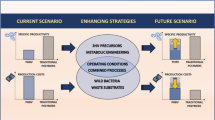Abstract
The degradation of the 4(3',5'-dimethyl-3'-heptyl)-phenol (p353NP)nonylphenol isomer in cultures of Sphingomonas TTNP3 supplemented withthe technical mixture of nonylphenol was first assessed. Then the radioactive andnon-labelled form of these diastereomers were both synthesised. The radioactiveisomers were synthesised using [ring-U-14C]-labelled phenol and3,5-dimethyl-3-heptanol by Friedel and Crafts alkylation. The time-course ofdegradation was performed with and without 14C-p353NP; balancing of radioactivity was calculated from different soluble fractions (organic, aqueous), bacterial biomass, and 14CO2 evolved as mineralization product. Thenoticeable portion of 14C bound to biomass showed that atleast the aromatic ring of 14C-p353NP was degradedand served as energy source and probably as carbon source forbacterial growth. In addition, the appearance of 3,5-dimethyl-3-heptanol,the nonanol corresponding with the side-chain of p353NP,was demonstrated in the bacterial media, and its concentrationdetermined during the course of fermentation. Besides the parent14C-p353NP, no other radioactive compounds,i.e. metabolites of 14C-p353NP were detectedin the media.
Similar content being viewed by others
References
Dachs J, Van Ry DA & Eisenreich SJ (1999) Occurrence of estrogenic nonylphenols in the urban and coastal atmosphere of the lower Hudson River estuary. Environ. Sci. Technol. 33: 2676–2679
Di Corcia A, Costantino A, Crescenzi C, Marinoni E & Samperi R (1998) Characterization of recalcitrant intermediates of the branched alkyl side chain of nonylphenol ethoxylate surfactants. Environ. Sci. Technol. 32: 2401–2409
Ekelund R, Granmo Å, Magnusson K & Berggren M. (1993) Biodegradation of 4-nonylphenol in seawater and sediment. Environ. Pollut. 79: 59–61
Espadaler I, Caixach J, Om J, Ventura F, Cortina M, Paun, F & Rivera J (1997) Identification of organic pollutants in Ter river and its system of reservoirs supplying water to Barcelona (Catalonia, Spain): a study by GC/MS and FAB/MS. Water Res. 31: 1996–2004
Fujii K, Urano N, Kimura S, Nomura Y & Karube I (2000a) Microbial degradation of nonylphenol in some aquatic environments. Fish. Sci. 66: 44–48
Fujii K, Urano N, Ushio H, Satomi M, Iida, H, Ushio-Sata N & Kimura S (2000b) Profile of a nonylphenol-degrading microflora and its potential for bioremedial applications. J. Biochem. 128: 909–916
Fujii K, Urano N, Ushio H, Satomi M & Kimura S (2001) Sphingomonas cloacae sp. nov., a nonylphenol-degrading bacterium isolated from wastewater of a sewage-treatment plant in Tokyo. Int. J. Syst. Evol. Microbiol. 51: 603–610
GigerW, Ahel M, Koch M, Laubscher HU, Schaffner C & Schneider J (1987) Behaviour of alkylphenolpolyethoxylate surfactants and of nitrilotriacetate in sewage treatment. Wat. Sci. Technol. 19: 449–460
Harayama S (1997) Polycyclic aromatic hydrocarbon bioremediation design. Curr. Opin. Biotechnol. 8: 268–273
Hesselsøe M, Jensen D, Skals K, Olesen T, Moldrup P Roslev P, Krog Mortensen G & Henriksen K (2001) Degradation of 4-nonylphenol in homogeneous and nonhomogeneous mixtures of soil and sewage sludge. Environ. Sci. Technol. 35: 3695–3700
Liber K, Knuth ML & Stay FS (1999) An integrated evaluation of the persistence and effects of 4-nonylphenol in an experimental littoral ecosystem. Environ. Toxicol Chem. 18: 357–362
Razo-Flores E, Donlon B, Field J & Lettinga G (1996) Biodegradability of N-substituted aromatics and alkylphenols under methanogenic conditions using granular sludge. Wat. Sci. Tech. 33: 45–57
Rieger PG, Meier HM, Gerle M, Vogt U, Groth T & Knackmuss HJ (2002) Xenobiotics in the environment: present and future strategies to obviate the problem of biological persistence. J. Biotechnol. 94: 101–123
Soto AM, Justica H, Wray JW & Sonnenschein C (1991) Paranonylphenol: an estrogenic xenobiotic released from polystyrene. Environ. Health Perspect. 92: 167–173
Stanier RY, Palleroni JJ & Doudoroff M (1966) The aerobic pseudomonads: a taxonomic study. J. Gen. Microbiol. 43: 159–271
Sundaram KMS & Szeto S (1981) The dissipation of nonylphenol in stream and pond water under stimulated field conditions. J. Environ. Sci. Health. B16: 767–776
Tanghe T, Devriese G & Verstraete W (1998a) Nonylphenol degradation in lab scale activated sludge units is temperature dependent. Wat. Res. 32: 2889–2896
Tanghe T & Verstraete W (1998b) Fate and degradation of the xenoestrogenic nonylphenol during biological waste water treatment. Med. Fac. Landbouww. Univ. Gent 63: 1873–1880
Tanghe T, Devriese G & Verstraete W (1999a) Nonylphenol and estrogenic activity in aquatic environmental samples. J. Environ. Qual. 28: 702–709
Tanghe T, Dhooge W & Verstraete W (1999b) Isolation of a bacterial strain able to degrade branched nonylphenol. Appl. iron. Microbiol. 65: 746–751
Tanghe T, Dhooge W & Verstraete W (2000) Formation of the metabolic intermediate 2,4,4-trimethyl-2-pentanol during incubation of a Sphingomonas sp. Strain with the xeno-estrogenic octylphenol. Biodegradation 11: 11–19
Topp E & Starratt A (2000) Rapid mineralization of the endocrinedisrupting chemical 4-nonylphenol in soil. Environ. Toxicol. Chem. 19: 313–318
Vallini G, Frassinetti S & Scorzetti G (1997) Candida aquaetextoris sp. nov., a new species of yeast occurring in sludge from a textile industry wastewater treatment plant in Tuscany, Italy. Int. J. Syst. Bacteriol. 47: 336–340
Vinken R, Schmidt B & Schäffer A (2002) Synthesis of tertiary 14Clabelled nonylphenol isomers. J. Label. Compd. Radiopharm. 45: 1253–1263
Wheeler TF, Heim JR, LaTorre MR & Janes B (1997) Mass spectral characterization of p-nonylphenol isomers using high-resolution capillary GC-MS. J. Chromatographic Sci. 35: 19–30
White DC, Sutton SD & Ringelberg DB (1996) The genus Sphingomonas: physiology and ecology. Curr. Opin. Biotechnol. 7: 301–306
Author information
Authors and Affiliations
Corresponding author
Rights and permissions
About this article
Cite this article
Corvini, P., Vinken, R., Hommes, G. et al. Degradation of the Radioactive and Non-labelled Branched 4(3',5'-dimethyl 3'-heptyl)-phenol Nonylphenol Isomer by Sphingomonas TTNP3. Biodegradation 15, 9–18 (2004). https://doi.org/10.1023/B:BIOD.0000009937.20251.d2
Issue Date:
DOI: https://doi.org/10.1023/B:BIOD.0000009937.20251.d2




